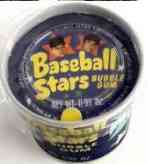1955 Topps DoubleHeader #.37 Wally Moon / #38 Joe Cunningham ROOKIE
(Cardinals)

Please wander around the website for more info, prices, values & images
on vintage baseball, football, basketball, hockey, sport and non-sports cards.
1970/1972/1973 Topps Candy Lids |

Cabinet Card Were oversized trading cards featuring paintings issued mostly 1910-1915.
Card Show is a gathering of dealers & collectors looking to buy/sell/trade sports cards and memorabilia.
Card Stock is the material a card is printed on. Usually paper-based, today companies play with the card stock and sometimes it appears to be wood or leather or see-thru acrylic ...
Cello Pack is a card pack whose wrapper is see-thru plastic. Usually the top & bottom cards are seen. Unopened cello packs showing major stars and rookies sell for heavy premiums.
Centering is the balance of the borders: top/bottom & left/right. On perfectly-centered cards, top/bottom borders match as do the left/right borders. Centering is presented as a set of numbers & directions and often included with the grade. Perfectly-centered is "50/50 t/b" AND "50/50 l/r". As centering gets worse, one number increases and the other decreases. For example: 90/10 t/b is considered extremely off-center top to bottom. The numbers add up to 100 (50/50, 60/40, 90/10 ...).
Certificate Of Authenticity (COA) A document used to verify legitimacy of a collectible. NOTE: Keep in mind that COA's are easier to fake then autographs.
Common A card of a non-star player is considered a "Common" as opposed to cards of a star players or specialty/subset cards such as league leaders, teams cards, World Series cards...
Condition (Grade) Centering, corner wear, photo clarity, edges, creases, print flaws ... all combine to determine a card's condition or grade. Along with rarity/scarcity it is the major factor in a card's value.
Crease Defect usually caused by bending the card. Hard to see, or not, a crease lowers the card's grade (VG or lower) and greatly diminishes it's value.

 Topps has tried many crazy products, often called "test issues".
Test issues were usually only distributed in limited areas and were difficult
to find. Candy Lids were one of Topps most unusual; little tubs of candy
with player's photos on bottom of the 1 7/8" lids. The 10 cent candy's came 24 to a box.
Sealed tubs can still be found in the $150 to $200 range. Called "Baseball
Stars Bubble Gum", the 1970 Topps Candy Lids set had 24 different
players, while 1973 Topps Candy Lids had 55.
Topps has tried many crazy products, often called "test issues".
Test issues were usually only distributed in limited areas and were difficult
to find. Candy Lids were one of Topps most unusual; little tubs of candy
with player's photos on bottom of the 1 7/8" lids. The 10 cent candy's came 24 to a box.
Sealed tubs can still be found in the $150 to $200 range. Called "Baseball
Stars Bubble Gum", the 1970 Topps Candy Lids set had 24 different
players, while 1973 Topps Candy Lids had 55. 

 Topps released their first Candy Lids in 1970. The 1970 Topps Candy Lids
are very, very hard to find and had small photos of Tom Seaver,
Carl Yastrzemski and Frank Howard.
Topps released their first Candy Lids in 1970. The 1970 Topps Candy Lids
are very, very hard to find and had small photos of Tom Seaver,
Carl Yastrzemski and Frank Howard.  Topps released two other test issue sets in 1973 (1973 Topps Pinups and 1973 Topps Comics).
The 1973 Topps Comics and 1973 Topps Candy Lids shared many photos and again
had no team logos. If thinking "licensing dispute", you are likely right.
Topps received player's union's permission for these test issues, but not
Major League Baseball's. Issues over rights & fees with MLBPA and the player's
union resulted in Topps started shutting down future production of test
issues putting an end to some of their most fun collectibles.
Topps released two other test issue sets in 1973 (1973 Topps Pinups and 1973 Topps Comics).
The 1973 Topps Comics and 1973 Topps Candy Lids shared many photos and again
had no team logos. If thinking "licensing dispute", you are likely right.
Topps received player's union's permission for these test issues, but not
Major League Baseball's. Issues over rights & fees with MLBPA and the player's
union resulted in Topps started shutting down future production of test
issues putting an end to some of their most fun collectibles. 